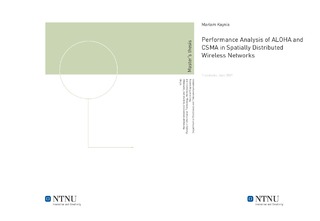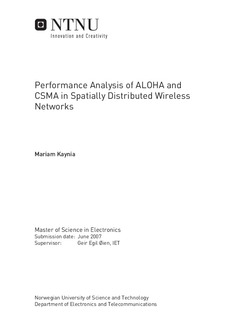| dc.description.abstract | In this thesis the performance of the ALOHA and CSMA MAC protocols are analyzed in spatially distributed wireless networks. The main measurement metric used is probability of outage, a metric that is referred to in most of the related research done in this field, but has not been treated in detail thus far. Some of the research done on other performance metrics such as transmission capacity, throughput, bit error rate, spatial reuse and delay are also noted and described briefly in this report. In our system model, users/packets arrive randomly in space and time according to a Poisson point process, and are thereby transmitted to their intended destinations using a fully distributed MAC protocol (either ALOHA or CSMA). Our model allows simultaneous transmissions between many transmitter-receiver pairs in the network. An SINR-based model is considered, and a packet transmission is encountered as successful if the received SINR is above a predetermined threshold value for the entire duration of the packet. Accurate bounds on the probability of outage, which is a function of the density of transmissions, are developed for both MAC protocols. The methods used to reach the obtained analytical results are presented in detail, and the analytical results are shown to follow the simulation results tightly. We also present the methods that were used to find expressions for the outage probability, which turned out to not be as successful as desired in terms of following the simulation results tightly for all densities. Furthermore, the derived bounds for the probability of outage are used to determine the performance advantage that CSMA provides over ALOHA and also to gain insight into the design of general MAC protocols for ad hoc networks. Our final comparison results show that CSMA performs better than unslotted ALOHA, and worse than slotted ALOHA in terms of probability of outage. | nb_NO |

